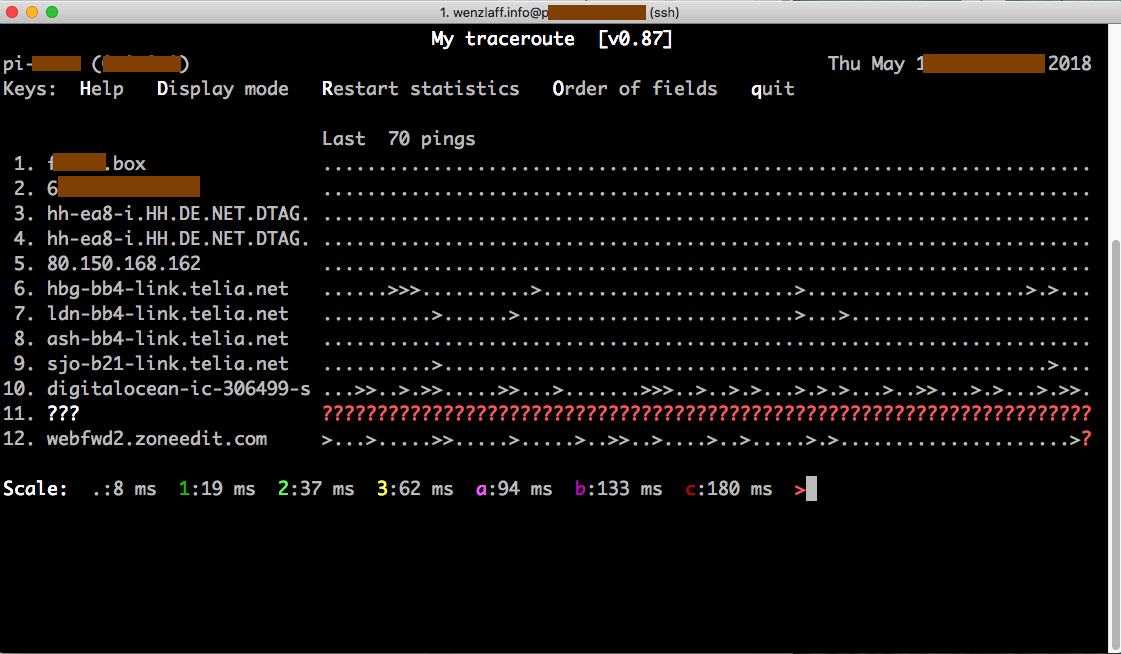Manchmal will man das Netzwerk analysieren und sehen wie der Weg zum Zielrechner läuft. Das geht mit Traceroute. Also z.B. traceroute wenzlaff.de
|
1 2 3 4 5 6 7 8 |
traceroute wenzlaff.de traceroute to wenzlaff.de (81.169.145.80), 30 hops max, 60 byte packets 1 home (x.x.x.x) 1.647 ms 1.675 ms 2.276 ms 2 x.x.x.x (x.x.x.x) 10.776 ms 10.113 ms 9.227 ms 3 f-ed3-i.F.DE.NET.DTAG.DE (62.154.14.138) 16.637 ms 16.677 ms 16.472 ms 4 xe-3-0-1.atuin.as6724.net (62.157.249.198) 16.257 ms 16.188 ms 16.091 ms 5 vl481.fiddlersriddle.as6724.net (81.169.144.121) 16.120 ms 16.333 ms 17.368 ms 6 w80.rzone.de (81.169.145.80) 17.462 ms 18.176 ms 18.442 ms |
Interesannter wird es in Verbindung mit dem ping. Dazu installieren wir das mtr programm mit sudo apt-get install mtr und schauen uns die Hilfe des Programms mit mtr -h an:
|
1 2 3 4 5 6 7 8 9 10 11 |
wenzlaff.info@pi-zero:/home/pi $ mtr -h usage: mtr [--help] [--version] [-4|-6] [-F FILENAME] [--report] [--report-wide] [--displaymode MODE] [--xml] [--gtk] [--curses] [--raw] [--csv] [--json] [--split] [--no-dns] [--show-ips] [-o FIELDS] [-y IPINFO] [--aslookup] [-i INTERVAL] [-c COUNT] [-s PACKETSIZE] [-B BITPATTERN] [-Q TOS] [--mpls] [-a ADDRESS] [-f FIRST-TTL] [-m MAX-TTL] [-U MAX_UNKNOWN] [--udp] [--tcp] [--sctp] [-P PORT] [-L LOCALPORT] [-Z TIMEOUT] [-G GRACEPERIOD] [-M MARK] HOSTNAME See the man page for details. |
Ok, wir starten nun mtr mit dem Zielhost z.B. mit mtr wenzlaff.de und erhalten einen interaktiven Dialog. Wir klicken nun die d Taste und erhalten den Status in Echtzeit der letzten 70 Pings in einem schönen Diagramm:
Mit der h Taste, gibt es Hilfe:
|
1 2 3 4 5 6 7 8 9 10 11 12 13 14 15 16 17 18 19 |
Command: ?|h help p pause (SPACE to resume) d switching display mode e toggle MPLS information on/off n toggle DNS on/off r reset all counters o str set the columns to display, default str='LRS N BAWV' j toggle latency(LS NABWV)/jitter(DR AGJMXI) stats c <n> report cycle n, default n=infinite i <n> set the ping interval to n seconds, default n=1 f <n> set the initial time-to-live(ttl), default n=1 m <n> set the max time-to-live, default n= # of hops s <n> set the packet size to n or random(n<0) b <c> set ping bit pattern to c(0..255) or random(c<0) Q <t> set ping packet's TOS to t u switch between ICMP ECHO and UDP datagrams y switching IP info z toggle ASN info on/off |
Das Programm kann auch einen Report im JSon Format ausgeben mit: mtr –json wenzlaff.info und in XML mit mtr –xml wenzlaff.info oder CSV analog.
Man kann sich auch selbst eine Version compilieren, den C-Code gibt es auf GitHub (https://github.com/traviscross/mtr). Folgende Schritte sind nötig und in ein paar Minuten auf dem Raspberry Pi erstellt:
|
1 2 3 4 5 6 7 8 9 10 11 12 13 14 |
# git repo clonen git clone https://github.com/traviscross/mtr.git # in das Verzeichnis gehen cd mtr # compilieren und bauen ./bootstrap.sh && ./configure && make # nach ein paar minuten ist das Programm gebaut wurden und kann gestartet werden mit sudo ./mtr wenzlaff.de # wenn wir die Version installieren wollen noch ein sudo make install |
Und schon hat man die aktuelle Version 0.92.56:
Aber nur auf die eigenen Server loslassen 😉


